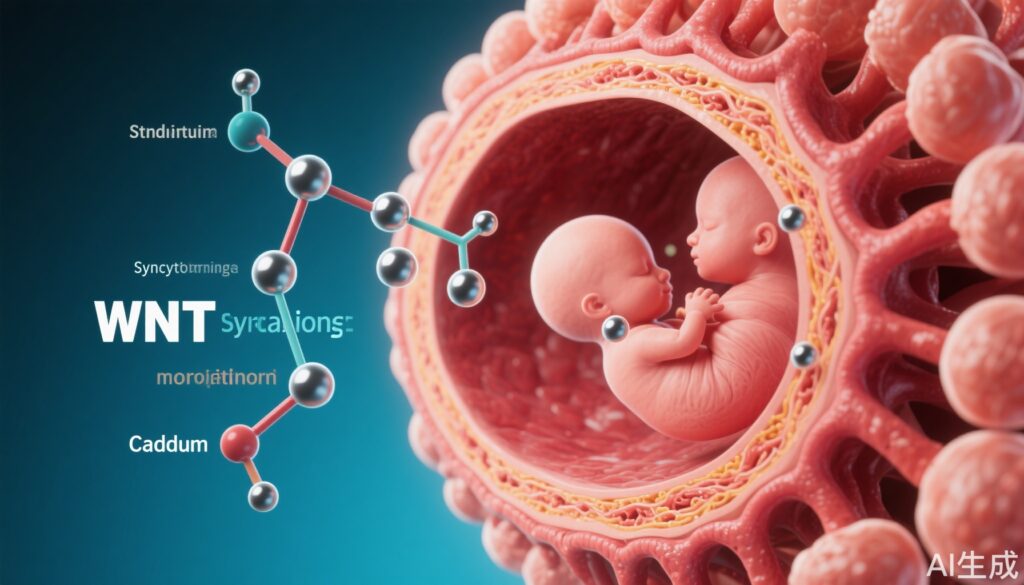Highlights
- Low-dose cadmium (Cd) exposure in early pregnancy is associated with more than double the risk of developing gestational diabetes mellitus (GDM).
- Cadmium promotes placental syncytiotrophoblast differentiation and alters mitochondrial metabolism, skewing glucose utilization and enhancing insulin-resistance hormone production.
- Mechanistic insights reveal that environmental Cd may drive GDM risk via placental metabolic reprogramming rather than direct maternal glucose dysregulation alone.
Study Background and Disease Burden
Gestational diabetes mellitus (GDM) is a common pregnancy complication, affecting up to 15% of pregnancies globally. It is characterized by glucose intolerance with onset or first recognition during pregnancy, resulting from a mismatch between increased placental insulin-resistance hormones and insufficient compensatory insulin secretion. GDM heightens the risk for adverse maternal and neonatal outcomes, including preeclampsia, macrosomia, and long-term type 2 diabetes in both mother and offspring. While classical risk factors like obesity, age, and genetics are well established, emerging evidence suggests that environmental toxicants—including heavy metals—may also contribute. Cadmium (Cd), a pervasive environmental pollutant encountered via food, water, and tobacco, is a known endocrine disruptor. However, the relationship between low-dose prenatal Cd exposure and GDM risk has been unclear, and the underlying placental mechanisms remain largely unexplored.
Study Design
This investigation, as reported by Chen H et al. (2025), employed a robust birth cohort design, enrolling 462 women who developed GDM and 924 matched controls from the same population. Blood samples were collected during early pregnancy to quantify plasma Cd concentrations. To elucidate potential biological mechanisms, the researchers complemented the clinical data with in vitro placental models: human trophoblast organoids and differentiated syncytiotrophoblasts (STBs). These models allowed for targeted exposure to Cd at concentrations mirroring those observed in the cohort (0.08 μM, corresponding to the 95th percentile) and subsequent assessment of metabolic, signaling, and hormonal changes.
Key Findings
Epidemiological Association:
Women who developed GDM had a significantly higher mean plasma Cd concentration in early pregnancy (0.37 μg/l) compared to controls (0.12 μg/l). Multivariable analysis showed a strong, dose-dependent association between elevated Cd levels and GDM risk, with an odds ratio (OR) of 2.15 (95% CI: 1.84–2.50). This association persisted after adjusting for key confounders such as age, BMI, parity, and socioeconomic status, underscoring the independent contribution of Cd exposure.
Mechanistic Insights from Placental Models:
– WNT Signaling and STB Differentiation: Exposure of STBs to low-dose Cd (0.08 μM) upregulated WNT pathway signaling and increased expression of ACSM1, a gene involved in fatty acid beta-oxidation. Enhanced WNT signaling is crucial for STB differentiation and placental development, suggesting that Cd may accelerate or dysregulate these processes.
– Mitochondrial Metabolism: Cd treatment enhanced mitochondrial respiration in STBs, with glucose identified as the predominant substrate fueling this increased activity. Interestingly, the upregulated beta-oxidation did not translate into increased tricarboxylic acid (TCA) cycle activity for energy production; instead, the diverted metabolic intermediates appeared to support steroid hormone synthesis.
– Hormone Production: Notably, STBs exposed to Cd produced higher levels of insulin-resistance hormones (e.g., placental lactogen, progesterone). This hormonal shift could amplify maternal insulin resistance and tip the delicate balance toward hyperglycemia, a hallmark of GDM.
Integrative Interpretation:
The findings suggest that even low-dose prenatal Cd exposure can substantially reprogram placental metabolic and endocrine functions. Rather than direct pancreatic or hepatic effects, the primary insult appears to occur at the maternal-fetal interface—the placenta—where Cd-induced changes in STB differentiation, mitochondrial metabolism, and hormone output collectively promote a metabolic milieu favoring GDM.
Expert Commentary
These results provide compelling clinical and mechanistic evidence linking environmental Cd exposure to GDM risk, filling a crucial gap in our understanding of how toxicants affect pregnancy outcomes. The use of human placental models adds physiological relevance and translational value, moving beyond associative epidemiology to causal inference. However, several limitations warrant discussion. First, although the cohort was well-characterized and adjusted for confounders, residual bias from unmeasured variables (e.g., diet, co-exposures) cannot be excluded. Second, in vitro models, while informative, may not fully recapitulate the complexity of in vivo placental-maternal interactions. Nonetheless, this work highlights the placenta as a central mediator of environmental risk—a paradigm that could extend to other toxicants and pregnancy complications.
From a public health perspective, these findings underscore the need for stricter regulation of environmental Cd, especially in populations of reproductive age. Screening for environmental exposures may become a critical component of preconception and prenatal care.
Conclusion
Low-dose cadmium exposure in early pregnancy is an independent and potent risk factor for gestational diabetes mellitus, acting primarily through placental metabolic and hormonal reprogramming. These insights not only inform risk stratification and preventive strategies for GDM but also advance our mechanistic understanding of how environmental pollutants impact maternal-fetal health. Future research should focus on intervention studies, long-term offspring outcomes, and investigation of additive or synergistic effects with other environmental toxicants.
References
1. Chen H, Bin J, Cao Z, Luo Y, Song P, He J, Lu S, Mahai G, Zheng J, Li Y, Qin J. Role of low-dose cadmium exposure to the pathogenesis of gestational diabetes mellitus. Environ Pollut. 2025 Oct 1;382:126718. doi: 10.1016/j.envpol.2025.126718. Epub 2025 Jun 24. PMID: 40571113.
2. American Diabetes Association. Management of Diabetes in Pregnancy: Standards of Medical Care in Diabetes—2024. Diabetes Care. 2024;47(Suppl 1):S237–S248.
3. Kippler M, Tofail F, Gardner R, et al. Maternal cadmium exposure during pregnancy and size at birth: a prospective cohort study. Environ Health Perspect. 2012;120(2):284-289.



